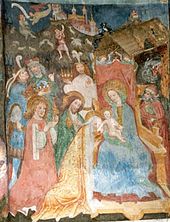Parish Church of St. Gandolf
The parish church of St. Gandolf in the municipality of Glanegg , surrounded by a cemetery wall , is visible from afar on a hill. The church, first mentioned in 1136, has been a parish since 1285/1293.
Building description
The church is a 14th century building that was changed in the second quarter of the 15th century. The sacristy is built to the north of the strongly recessed polygonal choir from the 14th century . The roofs of the church were covered with larch shingles in 1995. The protruding tower with ogival sound openings and a pointed gable helmet is on the southern half of the west facade. To the north of this is an open porch with raised ground level. Next to the entrance is a figure of Christ in mourning from the middle of the 18th century. The profiled narrow west portal is probably fitted into the arch of the 14th century.
Inside, two polygonal supports with bases and capitals divide the nave into two naves and three bays . The ribbed vault from the 15th century ends in wall services and above the pointed, beveled triumphal arch in a console . The location of the flat ceiling of the 14th century can be seen in the eastern part of the north and south walls by the protruding edges. The wooden west gallery is only accessible via the tower. The ribbed vault in the two-bay choir with five-eighth end rests in the two bays on brackets and in the choir end on round services with bases and capitals. On the north side of the choir, a round arched beveled portal with an iron-studded door leads into the barrel-vaulted sacristy. The sacrament niche from the second quarter of the 15th century is decorated with crabs on the profiled keel arch . Of the three two-lane Krabbe tracery windows in the end of the choir, the middle one is walled up and the others have changed in later times.
Murals
The frescoes on the north side of the nave and on parts of the triumphal arch, which were exposed again in 1937/1939, were painted around 1400 by the Villach workshop of master Friedrich with the participation of his son Johannes von Laibach . In the top row, the procession and the adoration of the Magi and the dragon fight of St. George are shown. Below you can see the Bethlehemite child murder , the flight into Egypt , the birth of Christ, Christ before Pilate , the flagellation of Christ, Christ is nailed to the cross and a multi-figure crucifixion. The scenes were partially fragmented by a later installation of an altar. The wall paintings with six apostles on the south wall of the choir were created around 1430. The fresco on the right triumphal arch wall was created in 1499 and was uncovered in 1999. It depicts a Madonna with radiant glory, flanked by Saints Andrew and Catherine . A donor figure kneels at the feet of the Madonna.
Facility
The rococo high altar was taken in 1767 and fills the choir in height and width. The middle picture shows St. Gandolf , to the side are the statues of St. John Nepomuk and presumably St. Francis de Sales as well as St. Oswald and Donatus above the sacrificial passage portals . The top picture shows the Holy Trinity . The carved antependium with Jesus as the good shepherd is adorned with foliage and ribbon .
The left side altar from 1743 was demolished because of the exposed frescoes. Today only the carved antependium with the depiction of a Pietà is preserved. The right side altar with swinging architecture and twisted leaf vine columns was made by Franz Anton Zeisler in 1752. The altar bears a statue of St. Johannes Nepomuk , in the essay a figure of St. Martin . The pulpit with sound cover from 1739 is painted on the pulpit with the four evangelists . The organ, made around 1680, has wings from the mid-18th century. On the outside you can see the Annunciation and inside King David and St. Cecilia .
Other features of the church include painting of a crowning with thorns and St. Charles Borromeo in the 18th century, the figures of a Pietà and the Holy Florian and Gandolf from the 18th century, a fabricated around 1500 baptismal font with shields and two Lauchterengel the early 18 Century.
literature
- Dehio manual. The art monuments of Austria. Carinthia . Anton Schroll, Vienna 2001, ISBN 3-7031-0712-X , p. 723 ff.
- Gottfried Biedermann and Karin Leitner: Gothic in Carinthia - With photos by Wim van der Kallen. Carinthia Verlag, Klagenfurt 2001, ISBN 3-85378-521-2 , p. 170 ff.
Web links
Coordinates: 46 ° 42 ′ 31.6 ″ N , 14 ° 12 ′ 5 ″ E








